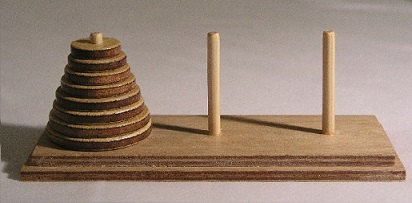
[?] Subscribe To This Site

Tower of Hanoi algorithm1.- Introduction2.- Presentation of main ideas and code 3.- Play the Puzzle!! 1.- Introduction to the algorithm of the Towers of Hanoi in Matlab
The puzzle starts with the disks in a neat stack in ascending order of size on one rod, the smallest at the top, and then making a conical shape.  Try to move all the disks onto another pole. Thing is, you can only move one disk at a time and you must follow size order (a bigger disk can't go on a smaller disk). Good luck! |
This is the main function (the one that is going to call itself many times).
function m(n, init, temp, fin)
if n == 1
% display your move
disp([init ' to ' fin])
else
% move n-1 disks from A to B, with C as temp
m(n-1, init, fin, temp);
% move disk from A to C, with B as temp
m(1, init, temp, fin);
% move n-1 disks from B to C, with A as temp
m(n-1, temp, init, fin);
end
You can call it providing the number of disks and the names of the towers.
n = 3;
m(n, ' A', ' B', ' C')
This is the complete result of the moves for 3 disks...
A to C
A to B
C to B
A to C
B to A
B to C
A to C
3.- Play the Game!
Free JavaScripts
provided
by The JavaScript Source
by The JavaScript Source
From 'Tower of Hanoi algorithm' to home
From 'Tower of Hanoi algorithm' to 'Fun menu'
Credits: CC BY-SA 3.0, Link
| Top |

       
|
        |


